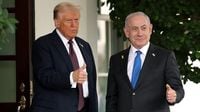Standing side by side in Washington, DC, on September 29, 2025, US President Donald Trump and Israeli Prime Minister Benjamin Netanyahu presented a united front to the world. Netanyahu, speaking at the White House, publicly endorsed Trump’s 20-point plan to end Israel’s war on Gaza, a conflict that has left more than 66,000 Palestinians dead and Israeli society deeply divided. The moment was historic, but as the day wore on, it became clear that the path to peace is as fraught as ever, with political maneuvering, deep-seated opposition, and ambiguous promises threatening to unravel the deal before it even begins.
The Trump plan, as released by the White House, lays out a step-by-step process for ending hostilities and shaping Gaza’s future. Central to the proposal is the creation of a temporary international administration for Gaza, supervised by a “peace board” chaired by Trump himself and including figures such as former UK Prime Minister Tony Blair. The plan envisions an initial technocratic Palestinian government, with the longer-term goal of transitioning control to the Palestinian Authority (PA). It even leaves the door open—albeit only slightly—to the possibility of a Palestinian state, a notion that has long been anathema to Netanyahu and his right-wing coalition partners.
“I support your plan to end the war in Gaza, which achieves our war aims,” Netanyahu declared in English, standing beside Trump. Yet, just hours later, in a message delivered in Hebrew to his domestic audience, Netanyahu insisted, “No, absolutely not. It’s not even written in the agreement. But we did say one thing. That we would forcibly resist a Palestinian state.” According to BBC, this contradiction underscores the delicate balancing act Netanyahu faces: appeasing international partners while placating hardliners at home.
The plan’s details are significant. It calls for Israeli forces to withdraw to an agreed line, with the remaining hostages held by Hamas to be released within 72 hours of withdrawal. Hundreds of Palestinian prisoners would be freed from Israeli custody. Hamas members who pledge peaceful coexistence and surrender their arms would be granted amnesty and allowed to leave Gaza if they wish. Crucially, Hamas would have no role in governing the enclave, and a process of demilitarization would be overseen by a temporary international security force, involving both Arab and international partners. Aid to Gaza would be increased dramatically, including through the United Nations, and a “Trump economic development plan” would seek to rebuild the shattered territory.
Yet, for all its momentum, the plan is light on specifics. “Momentum is the plan’s strength. Its weakness is the lack of detail, a characteristic of Trumpian diplomacy,” noted BBC analyst Jeremy Bowen. The document includes a rough map for an Israeli pull-back but omits the nuts and bolts that determine whether a diplomatic agreement can hold. “If it is to work, hard negotiation will be necessary. In that process, there will be many opportunities for it to break down,” Bowen observed.
Trump himself set an urgent timetable, declaring that Hamas has “three or four days” to accept or reject the deal. “If Hamas rejects the deal, Bibi, you will have our full backing to do what you have to do,” Trump said, using Netanyahu’s nickname. He called on Arab and Muslim leaders to help push the deal across the line, emphasizing that “Netanyahu understands it’s time to end the war.” According to Axios, White House officials had grown increasingly frustrated with Netanyahu, seeing him as the biggest barrier to peace, and Trump was reportedly prepared to publicly break with the Israeli leader if he failed to endorse the plan.
Behind the scenes, diplomatic moves continued apace. As reported by Axios, Netanyahu called Qatari Prime Minister Mohammed bin Abdulrahman Al Thani during his White House visit to apologize for Israel’s recent strike on Doha—a key Qatari condition for resuming its mediation with Hamas. Trump, too, spoke with Qatar’s emir before Netanyahu’s arrival, highlighting the international stakes and the need for regional buy-in.
But the plan’s reception in Israel has been anything but unanimous. Far-right cabinet members, including National Security Minister Itamar Ben-Gvir and Finance Minister Bezalel Smotrich, have made their support for Netanyahu conditional on continuing, even expanding, the war in Gaza. Smotrich lambasted the Trump plan, calling it “a resounding diplomatic failure, a closing of eyes and turning our backs on all the lessons of October 7, and in my estimation, it will also end in tears.” Ben-Gvir, for his part, has focused his ire on Netanyahu’s apology to Qatar, viewing it as a capitulation under US pressure.
For the far-right settler movement, the plan is a bitter disappointment. As BBC noted, hardliners had previously championed far more radical proposals—such as the so-called “Trump Riviera” plan, which envisioned the removal of Gaza’s Palestinian population and its replacement with Jewish settlers. The new agreement explicitly rejects such measures, stating that no Palestinian will be forced to leave. Smotrich even compared the plan to the 1938 Munich Agreement, drawing a controversial parallel to the appeasement of Nazi Germany.
Meanwhile, mainstream opposition parties in Israel, including those led by Yair Lapid, have offered to support Netanyahu in pushing the deal through the Knesset, Israel’s parliament. Demonstrations calling for negotiations and the return of Israeli captives have persisted throughout the conflict, and recent polls suggest a majority of Israelis want to see an end to the war. Yet, Netanyahu has repeatedly chosen to align with the far right, whose vision for Gaza is far removed from the international consensus.
Internationally, the Trump plan has garnered support from leading Arab and Islamic countries, including Jordan, Egypt, Qatar, Saudi Arabia, the UAE, Pakistan, Indonesia, and Turkey. Foreign ministers from these states have expressed hope that the framework will lead to a full Israeli withdrawal, the rebuilding of Gaza, and a “path for just peace on basis of two-state solution under which Gaza is fully integrated with the West Bank in Palestinian state in accordance with international law.” This, as BBC points out, is a coded reference to longstanding international demands and the recent International Court of Justice ruling deeming Israel’s occupation of Palestinian land illegal.
Analysts remain skeptical about Netanyahu’s true intentions. Former Israeli diplomat Alon Pinkas told Al Jazeera that Netanyahu might seek to “kill it softly,” stalling implementation with claims of security concerns while escalating military action and rhetoric against Iran. Yossi Mekelberg of Chatham House suggested that Netanyahu’s horizon is defined by “political survival,” and that should his far-right allies desert him, he may call elections, claiming victory for dismantling Hamas and returning hostages. Yet, once the war ends, Netanyahu could find himself isolated, with rivals sensing weakness.
As the dust settles on the White House lawn, the future remains uncertain. The Trump plan’s ambiguity allows for vastly different interpretations, and the coming days will test whether its momentum can overcome the entrenched opposition, political calculation, and the sheer complexity of ending a conflict that has raged for generations. For now, the world waits to see whether this latest bid for peace will hold—or whether it will, as so many before it, unravel under the weight of history and mistrust.



